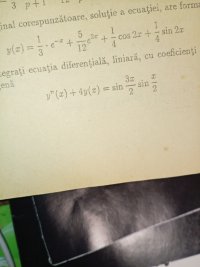You are using an out of date browser. It may not display this or other websites correctly.
You should upgrade or use an alternative browser.
You should upgrade or use an alternative browser.
Clueless about the Laplace Operational Method
- Thread starter wolly
- Start date
logistic_guy
Senior Member
- Joined
- Apr 17, 2024
- Messages
- 2,215
The factorial is part of the residue theorem formula.How does the denominator have these values?
[math]0![/math][math]1![/math][math]2![/math]@logistic_guy
Can you please explain?
For example, when the order of pole is \(\displaystyle 1\), you get
\(\displaystyle \frac{1}{(1 - 1)!} = \frac{1}{0!} = \frac{1}{1} = 1\)
when the order of pole is \(\displaystyle 2\), you get
\(\displaystyle \frac{1}{(2 - 1)!} = \frac{1}{1!} = \frac{1}{1} = 1\)
when the order of pole is \(\displaystyle 3\), you get
\(\displaystyle \frac{1}{(3 - 1)!} = \frac{1}{2!} = \frac{1}{2} \)
You can use Euler formula to simplify this.So z tends to [math]-2i[/math] and [math]2i[/math]?
[math]lim_{z \to 2i} f(z)*(z-2i)*e^{pt}[/math]and
[math]lim_{z \to -2i} f(z)*(z+2i)*e^{pt}[/math]
I mean I don't know how to calculate [math]e^{2it}[/math] and [math]e^{-2it}[/math]!
@logistic_guy
\(\displaystyle e^{2it} = \cos 2t + i\sin 2t\)
Usually when solving, we are interested in the real solution, so we take only \(\displaystyle \cos 2t\)
Yes it can.Also can the result of the limit of the residue have values like i,2i and so on?
Multiplicity means the order of the pole.It says in my book that [math]m_k[/math] is the order of multiplicity!
Where is \(\displaystyle f(z)\), I cannot see it. The method is usually Laplace transform.How did my differential equation from that function f(z) changed to this function?
Is there a method?
How did it got y(x)?
[math]f(z) = \frac{10}{(z^2+4)(z^3-2z^2-z+2)} + \frac{z^2-z-4}{z^3-2z^2-z+2}[/math]Where is \(\displaystyle f(z)\), I cannot see it. The method is usually Laplace transform.
logistic_guy
Senior Member
- Joined
- Apr 17, 2024
- Messages
- 2,215
Do you want to do it with the Residue theorem or partial fraction decomposition?[math]f(z) = \frac{10}{(z^2+4)(z^3-2z^2-z+2)} + \frac{z^2-z-4}{z^3-2z^2-z+2}[/math]
Residue theorem but I don't understand why you add every pole!Do you want to do it with the Residue theorem or partial fraction decomposition?
Can you explain that?
@logistic_guy That's what my book said that you need to add up every residue of each pole.
The question is why?
The question is why?
logistic_guy
Senior Member
- Joined
- Apr 17, 2024
- Messages
- 2,215

First this solution is only for \(\displaystyle f(z) = \frac{10}{(z^2 + 4)(z^3 - 2z^2 - z + 2)}\). If you add \(\displaystyle f(z) = \frac{z^2 - z - 4}{z^3 - 2z^2 - z + 2}\), you will get a different answer.
You add them because the solution is usually is done by partial fraction decomposition. Like thisResidue theorem but I don't understand why you add every pole!
Can you explain that?
\(\displaystyle f(z) = \frac{10}{(z^2 + 4)(z^3 - 2z^2 - z + 2)} = \frac{A}{z + 2i} + \frac{B}{z - 2i} + \frac{C}{z + 1} + \frac{E}{z - 1} + \frac{F}{z - 2}\)
You find the values of the letters and then you look at the Laplace transform table to get the solution which is mix of sin, cos, and e.
But when you do it with the residue theorem, the formula gives you the answer directly for each term. Then you have to add them to get the full solution.
So if you add these 2 fractions of f(z) you don't get that answer?View attachment 39351
First this solution is only for \(\displaystyle f(z) = \frac{10}{(z^2 + 4)(z^3 - 2z^2 - z + 2)}\). If you add \(\displaystyle f(z) = \frac{z^2 - z - 4}{z^3 - 2z^2 - z + 2}\), you will get a different answer.
So that means that f(z) is only the first fraction and not the second fraction as the answer?
@logistic_guy I'm confused!
logistic_guy
Senior Member
- Joined
- Apr 17, 2024
- Messages
- 2,215
Yes it is only the first fraction. And also they forgot to include the term for the pole \(\displaystyle z = 1\) which is \(\displaystyle -e^x\)So if you add these 2 fractions of f(z) you don't get that answer?
So that means that f(z) is only the first fraction and not the second fraction as the answer?
Yeah, it's normal to be confused. It is a little bit complicated topic. You will need some time to grasp it all. We all were confused too when we first studied it.@logistic_guy I'm confused!

